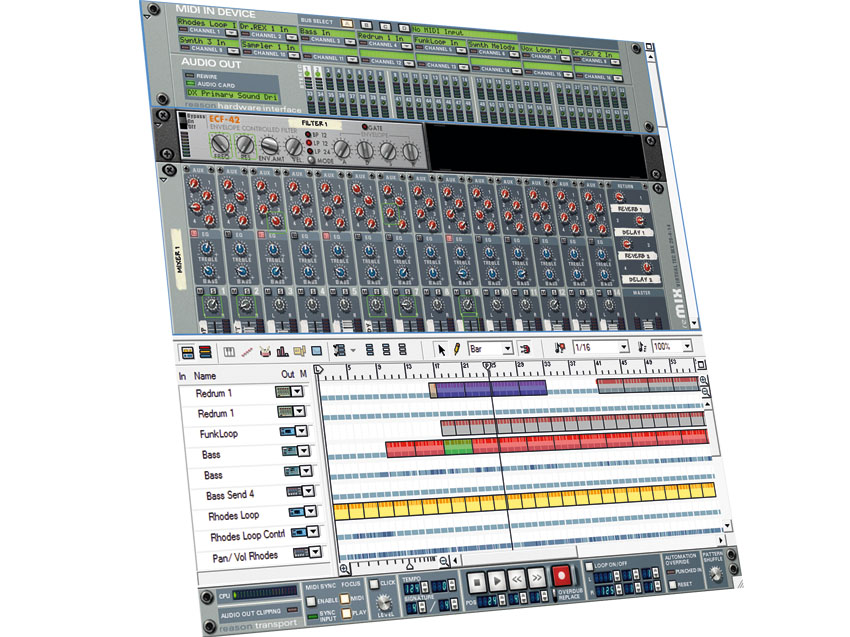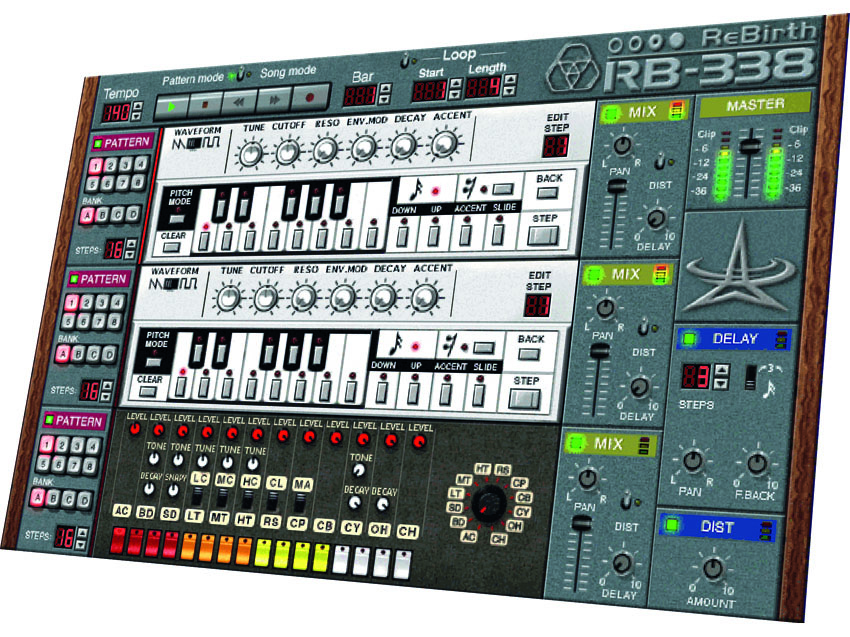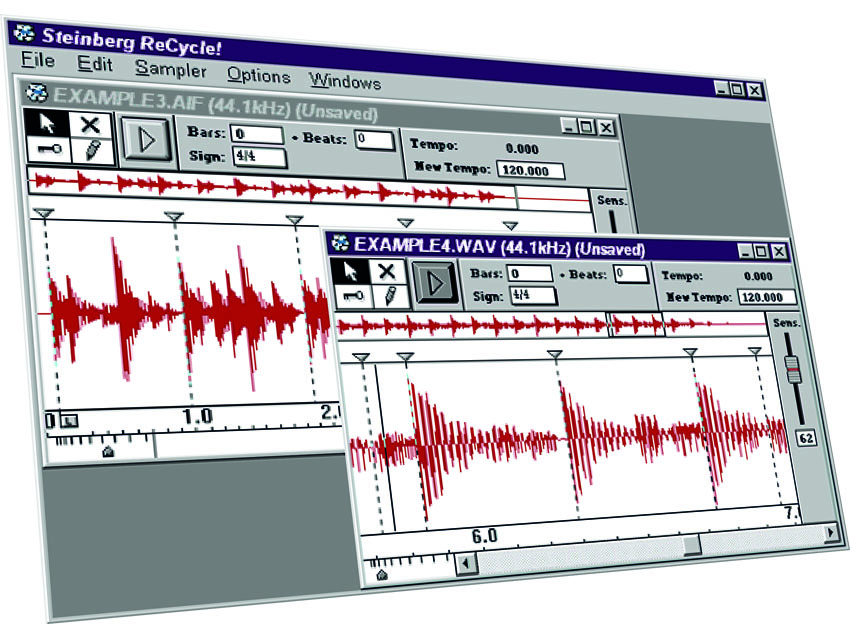A brief history of Propellerhead Reason and Record

Reason

ReBirth

ReCycle
Propellerhead's Reason may not technically qualify as a digital audio workstation per se, but as a MIDI sequencer and a seriously powerful production and composition package, it deserves to be considered alongside the likes of Logic and Cubase.
Record, launched just last year, can be thought of as a companion program to Reason or as a DAW in its own right. Together, they're one hell of a team.
Since its formation in 1994, Propellerhead has put together a serious challenge to the more established DAWs. Let's start with a look at the company's roots and then move onto a more thorough investigation of Reason and Record.
ReCycle and ReBirth
Propellerhead has only been around since the mid-'90s, but in its short lifetime it has released a series of groundbreaking pieces of software. The Stockholm-based company was founded in 1994 by Ernst Nathorst-Böös, Pelle Jubel and Marcus Zetterquist. Its first product was ReCycle, a utility developed in conjunction with Steinberg (creators of Cubase) that specialised in chopping up sampled loops.
At a time when software sampling had yet to offer a realistic alternative to traditional hardware samplers, ReCycle made it easy for producers to rearrange looped patterns and perform a basic form of time-stretching.
Samples could be sliced up in ReCycle and then transferred to a hardware sampler for playback. The application's REX and REX2 file formats remain popular to this day.
ReCycle was revolutionary in its own right, but dance music producers really sat up and took notice of Propellerhead in 1996, with the announcement of ReBirth RB-338, one of the most important virtual instruments in the history of electronic music.
Get the MusicRadar Newsletter
Want all the hottest music and gear news, reviews, deals, features and more, direct to your inbox? Sign up here.
In its short lifetime, Propellerhead has created revolutionary music software
At the time, software synthesis was most definitely in its infancy. ReBirth's highly sophisticated synthesis engine offered realistic emulations of Roland's TB-303 synth and TR-808 and TR-909 drum machines. ReBirth sparked a wave of interest in virtual instruments and showed just how effective real-time software synthesis could be.
The ReWire protocol, another joint project with Steinberg introduced to ReBirth in 1998, allowed MIDI and audio data to be transferred between applications with ease. Although similar protocols had already been released, ReWire was the first to live up to expectations and has since evolved into a de facto industry standard.
Reasonable
By the turn of the millennium, the DAW revolution was well under way. The maturation of home computer technology meant that it was now realistic for home users to create complete virtual studios from software.
Propellerhead spotted a gap in the market and had ended ReBirth development in 1999 to focus on a new product that would mount a serious challenge to the big boys: Reason.
Released in November 2000, Reason's approach was broadly similar to the likes of Logic and Cubase, but took the virtual studio concept even more literally. The user interface mimicked a rack full of equipment, allowing instruments, effects and mixers to be linked together in order to create a complete production setup. Hit the tab key and the rack flipped around to reveal the back panels of all the modules, complete with audio inputs and outputs for each device plus CV control connections.
Of course, all the usual MIDI sequencing features and editing options were available, but the interface made things feel distinctly different to most traditional DAWs. Furthermore, complex routing of audio and control signals that would normally cause major headaches was achieved with ease thanks to the cartoonish patch cables.
Reason offered no audio input features but with such a range of virtual instruments and samplers available the emphasis was on creating electronic music from scratch rather than recording external sounds.
Beyond Reason
Like almost any new software package, the first version of Reason had a handful of minor weaknesses, most of which were addressed in version two. The first major update, released in late 2002, focused heavily on upgrading Reason's sampling capabilities.
Version two introduced NN-XT, an upgraded version of the original NN-19 sampler module, added REX support for all samplers and enabled 24-bit sample playback (sampler modules were previously capable of loading 24-bit files but audio was dithered down to 16-bit on playback).
The company has always made bold decisions, so we shouldn't be suprised if it does it again
Since Reason has never offered third-party plug-in support, users are reliant on Propellerhead to upgrade and update the program's built-in instruments and effects on a regular basis in order to keep it on a par with its rivals. Despite occasional calls for their introduction, Propellerhead has stood firm on the plug-in issue, arguing that ReWire allows users to route audio to a separate plug-in host for processing.
Rhyme and reason
Over the next few years, Reason was gradually updated to allow it to compete even more fiercely with traditional DAWs.
2005 saw the release of version three, with the main focus being on the new Combinator module. Reason's modular arrangement inevitably led to complex routings of audio signals and control data, so it was perhaps a logical step to introduce a simplified method for handling complex setups of instruments and effects.
The Combinator device allows a group of devices to besaved and recalled as a single patch (a Combi). Rather than needing to load up various saved device settings and route signals, Combinator makes it easy to work with complex multi-layered setups, split instruments or just frequently used effect chains.
Reason 4, released in September 2007, saw an even bigger overhaul of the feature set. The Thor polyphonic modular synth stole most of the headlines with its phenomenally flexible editing options but a number of other updates and additions combined to make Reason even more flexible.
The ReGroove Mixer device, a clever implementation of groove template quantisation, allowed timing to be tweaked beyond the usual shuffle, while the new RPG8 arpeggiator could be used for note triggers or just for its range of CV outputs.
Even the sequencer section saw a radical re-working - tempo and time signature automation, track groups, a major graphical cleanup and a host of new editing features brought it up to scratch with the rest of the program.
By now, Reason was well established as one of the top choices for musicians looking for an all-in-one Electronic composition and production package. For most users, the single biggest weakness was the absence of audio recording features, but rumour had it Propellerhead was working on a solution…
Record
At the release of Reason 2, Propellerhead CEO Ernst Nathorst-Böös openly stated that the company wouldn't simply tack audio recording onto Reason to create "an inferior Cubase" but would consider producing an alternative program for audio.
In May 2009, the company announced Record, a new product which neatly plugged most of the gaps in Reason's feature set. With the emphasis on recording, editing, arranging and mixing audio, Record offers the audio features Reason users have long been missing and the two applications' flawless integration makes them a great combination. Reason projects can be opened in Record and everything's seamlessly handled in the one application.
Record isn't intended to replace Reason in the Propellerhead product line-up and it's not essential for Reason users, but there's no doubt that it addresses some of the older product's major weaknesses. Reason's lack of audio recording, third-party plug-in support or MIDI output is curious but easily explained: Reason was - and still essentially is - intended to be used in conjunction with another program to handle audio or plug-ins. The ReWire protocol means that it can run happily alongside another piece of software recording audio, hosting plug-ins and triggering external MIDI devices.
However, the long-awaited third-party plug-in support is still missing even in Record, with the emphasis again on a closed system to ensure stability. Whether this will always be the case remains to be seen. It would be a bold decision by Propellerhead to cut themselves off from the world of third-party plug-ins, but the company has always made bold decisions so we probably shouldn't be surprised if it does it again.
Repeat
The announcement of Reason 5 earlier this year proved that development wasn't slowing down, despite the arrival of Record. The updates this time around included the new Kong Drum Designer module and Dr Octo Rex, a new version of the Dr Rex loop player.
Blocks, a new pattern-based editing tool, makes arrangement and mixing even more flexible. As a further added bonus after all these years, Reason's samplers can finally actually sample audio.
No doubt there are plenty of Reason users who wish that all the audio features of Record could be integrated into the application, but that seems highly unlikely at this stage.
Regardless of which route Propellerhead chooses to go down next, the one thing we can be sure of is that it's never been afraid to tread a highly original path. Reason is in a class of its own.
Liked this? Now read: A brief history of Ableton Live
Connect with MusicRadar: via Twitter, Facebook and YouTube
Get MusicRadar straight to your inbox: Sign up for the free weekly newsletter
Future Music is the number one magazine for today's producers. Packed with technique and technology we'll help you make great new music. All-access artist interviews, in-depth gear reviews, essential production tutorials and much more. Every marvellous monthly edition features reliable reviews of the latest and greatest hardware and software technology and techniques, unparalleled advice, in-depth interviews, sensational free samples and so much more to improve the experience and outcome of your music-making.










